Welcome to my collection of third grade classroom photos! This pages includes photos of a 2nd grade classroom in Broward County, Florida, and classroom pics from a Miami, Florida 3rd grade classroom (as you read on, you’ll find out why I switched schools mid-year.) The classroom photos were taken by me in 2005. I’ve kept the text exactly the same as when I first uploaded the pictures to this website so that it feels like you’ve just walked into my room and are taking a tour!
Classroom pictures
WHAT A YEAR THIS HAS BEEN! I apologize to those who have been waiting for pics from this year–it’s now February 2005 and I am just finishing this page up. HERE’S WHY: I quit my job as a second grade teacher in Miami and got a new position as a third grade teacher in Fort Lauderdale. My new school is overcrowded and I will not have my own classroom until the new building addition is finished (*should be* any day now) so I am sharing a room with another teacher. Yes, co-teaching with 45 kids in one room! What an adventure! Here’s the story:
AUGUST, 2004- Inner-city Miami, 2nd grade
[This is what I posted on the site during this time]
I was horrified to learn 4 things about my new Florida school:
1) We can’t hang anything on the walls or door because they were just painted (and I love to cover every square inch of a room, not just bulletin boards!)
2) There is no window in my room (meaning I have to keep my overhead light on because without natural light, my lamps aren’t bright enough to turn the fluorescents off)
3) I could not keep my frig, microwave, or any food in my room nor could I eat in the room (aaaaggghh!)
4) There is a good reason why we can’t eat in the room. Bugs. Lots of them.
I’ve seen 7 schools in Miami and 2 did not have open courtyards and walkways, so this isn’t always the situation, but apparently in Florida a lot of schools have hallways that are not enclosed. Some of you are probably staring blankly at your screen wondering what the big deal is. Those of you from colder climates are probably trying to envision this and just can’t figure out how it works. I see it every day and am still not sure! There is an overhang in the ‘hallway’ so you don’t get rained on and the sun doesn’t beat down on you, but that causes a tremendous echo that makes any tiny giggle sound loud enough to disrupt an entire line of children. And the overhang doesn’t guard against unwelcome visitors. If you keep the classroom door open, you are inviting ants, the world’s biggest beetles and cockroaches, lizards, geckos, and creatures unimaginable to northerners. And when it rains, puddles form all up and down the walkways so the kids’ shoes get wet and squeak. NOT an ideal situation in terms of management.
But… this is the view I have when I open my classroom door on a beautiful day in the Sunshine State- notice the picnic tables for teaching, working, or eating outside:
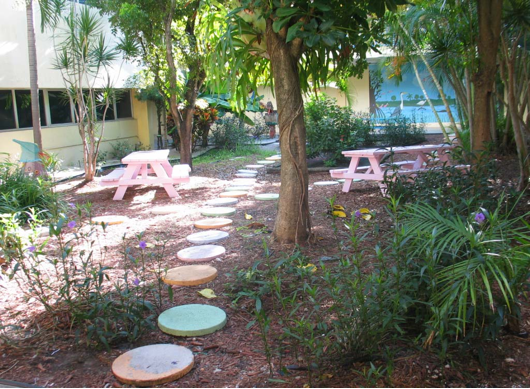
Here are the things I LOVE about my new school:
- I have a bathroom, sink, water fountain, and small storage closet.
- They are installing a white board instead of the old chalkboards I have always had.
- I have more materials (the room actually came with a classroom library, along with tons of math manips and some expensive phonics games)
- The office does all the photocopying and laminating for teachers, so we have to plan ahead and not demand things at the last minute, but I no longer have to spend hours doing that stuff myself!
- I have a part-time paraprofessional (a term I had forgotten even existed)
- I have about 8 hours a week of planning time during the school day (although some of that is set aside for meetings and professional development), as opposed to the 3 I used to have
- 6 computers in every classroom, all with internet access, and a functional printer
- The staff is soooooo friendly and helpful, from the cafeteria workers to office staff to administration to security (Yes! Security in an elementary school! Wonderful! Remember the school is not fully enclosed so security is in charge of the perimeters and signing in visitors). I have a LOT of support from all sides.
- Most of my kids walk home, which is great for two reasons. The first is that I don’t have to wait for any more late busses. The second is that I get to see a lot of the parents in the afternoon. That daily face-to-face contact is so invaluable. During the first week of school, I have already met about half of my parents.
- Later hours: 8:30-3:00 instead of 7:45-1:55. Having kids enter my room at 7:25 was very, very hard! By 8:20 when I get my kids now, I’m ready to go and so are they.
- Resources for kids and families: before school, after school, and Saturday tutoring is available for ALL kids for FREE. Teachers can volunteer to tutor for their regular hourly wage, which is great extra income, but more importantly, we can provide uninterrupted one-on-one instruction for kids who really need it. There’s also a parent resource center and lots of programs for parents to help them and their children achieve their goals.
- A visionary administration that has high expectations for students and staff and will not settle for anything less than the best. I feel a lot of pressure to get a lot accomplished, but I am constantly asked if I need anything and encouraged to make a request if I do. Admin is always in and out of the classrooms so they know what’s going on and are reminded on a daily basis just what teachers go through every day.
Now, let’s get on with the tour! The pictures were taken with my camera phone so the quality is not great. But, here are the views from 2 corners in the room…
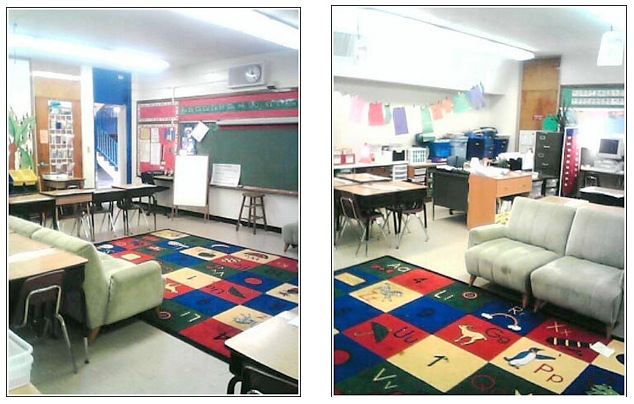
Desk arrangement- I started off with the kids sitting in teams, and I found that they were just too focused on each other and not on me. I gave it 2 weeks and just couldn’t take it anymore! I now have a team set up in which students are sitting in arrangements that work best for them as individuals. Some can handle to ‘table’ arrangement, and sit that way. Some need to sit all by themselves (like the 4 you can see in the picture above–they aren’t completely isolated, they just have some ‘breathing room’ to keep them from being distracted and distracting others). Most kids sit in a long line of 5 or 6 (like they did in my previous classroom). All other furniture is pushed to the perimeter so that there is a large space in the middle for teaching the whole class on the rug. If you know me at all, you know I change my room arrangement constantly, but I must say that I LOVE it like this. When the kids are close together, they get too noisy. I like them spread out. It also makes it easier for them to be doing different activities at the same time (some reading, some writing, some in centers, etc.). Unfortunately, I had to choose between storage for all my stuff (NOT an option after renting a U-Haul to drag it all in to the school from the storage I paid for all summer!), having a rug area, and having a small group table. I chose for the table to go. My small groups meet on the couch and rug with clipboards.
Teams- If I’m not using the board or overhead, I usually teach while walking through the middle so the entire class is practically within arm’s reach. I have 23 kids, so I have some larger teams (made of 6 students) and some smaller teams (made of 3 kids). The smaller teams are for students who do better when sitting alone but whom I don’t want to ostracize permanently from the class. The desks face front (rather than each other, for less distraction), and have sometimes about a foot of space between them. I usually put a ‘role model’ in the middle with two struggling students on either side, but the arrangement varies. The smaller teams are not considered by the kids to be any different from the other teams and are not a punishment. I usually move my kids around a few times per month so they are constantly working with new groups. Some kids just cannot keep from talking and disrupting others and have to sit alone. I try to move them back with the class after a good week, but some end up sitting alone again. It’s just a matter of finding what works best for the child. They can generally experience success when they sit alone, which makes them feel good, and then they can join the class for activities and partner work.
Team points- During the first few weeks of school, I used team points, as in “Team 1 is sitting quietly with hands folded, they get a point, Team 2 is ready, they get a point…” and so on. The winning team each day got to sit on the couch for Read-Aloud time. Now I stopped using the points and just comment on the behaviors I see (“Wow! Look at Team 3! They already have their books on page 27!”) with the praise being the reward, or use teams for natural consequences (“Team 5 has their desks cleared, they may line up, Team 4 is waiting for 2 more people and then they’ll be ready… wonderful, Team 4, you may go…” and so on.
Group area- I do a lot of teaching while sitting on the chair you saw above with the kids on the carpet. It’s an old, stained rug another teacher threw out but I vacuumed and Lysoled it and it’s scheduled for a cleaning soon, so I am glad I salvaged it. Kids who follow directions exceptionally well during initial activities get to sit on the couch during instruction; those who have been continually disruptive have permanent seats on chairs along the side in a pro-active measure to prevent further problems. I allowed the kids to sit where they wanted on the carpet for the first week but they now have assigned seats. I don’t mark the spaces on the rug (I used to do that for my PreK kids and it was SUCH a hassle): since this rug has pictures on it, I just assigned a particular one to each child and s/he memorizes it.
Meeting area furniture- This is inexpensive furniture from IKEA that migrated from my guestroom to my classroom because now that I am in Miami Beach, I no longer have a spare bedroom to keep it in! (The chair is part of the vintage sofa set from my grandmother, as explained in the 2004 tour.) I love having the shelving to keep all my teaching materials in and on–dry erase markers, charts, read aloud books, manipulatives, etc. etc. It’s all a bit messy in my photos, but hey, this is what the area really looks like after a full 8 hours of usage!
Here’s a more detailed tour, starting by the doorway and going clockwise:
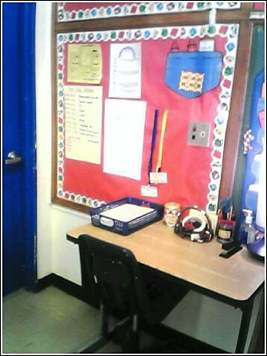
Welcome board- This is the area to your left when you walk in the classroom door. Here I post all info mandated by administration, as well as info for visitors, parents, and substitute teachers. You can also see my job helper chart (the pocket and overalls).
Volunteer/Para table- I am blessed to have a knowledgeable and hard-working para-professional in my room every Monday and an hour each Friday, as well as a dedicated parent volunteer for a half an hour each day (she comes on her lunch break!), and a few other wonderful volunteers who stop by on occasion. [This is a perfect example of why never to stereotype or judge a school or its population based on location.] I use the pictured adult-sized table and chair for them. I keep basket with a list of things I need done with asterisks by the most essential tasks. The list is kept inside the basket on the table along with all materials needed. Anyone who helps out in the room can choose a task and then cross it off my list and put the finished product on my desk. Anytime I think of anything for an assistant to do, I jot it on a sticky note and transfer it to the basket when I get a chance. [Update 2011: I now have a page on the site about this process called Volunteers and Aides.]
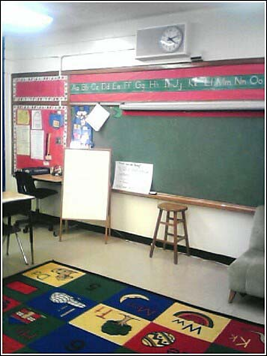
Teaching area- The chalkboard is ancient: it will not accept chalk well and is not magnetic, thereby rendering it basically worthless. I use some sticky double-sided tape that is reusable under my overhead screen (see the red stripe?) which I got from Highlights magazine for free to hang posters.
Chart- The chart stand is double sided. On one side is a flannel board which I don’t use and therefore covered with a wipe-off calendar from a discarded Every Day Counts math set. When students share their news during meetings, I write it on the calendar. The original concept which I believe was from Mailbox Magazine was to write the news on a large desk calendar, then at the end of the month, cut the squares up and staple into a little booklet for the reading area. Since I already had a wipe-off calendar and a chart stand that fits it perfectly, I decided not to spend money on that venture, but I still think it’s a fabulous idea!
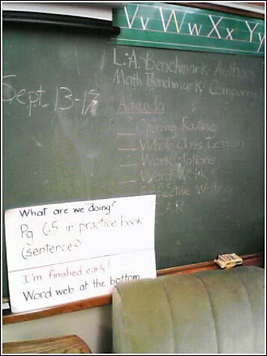
Benchmarks/Agenda- We are required to post these. I try to make them useful by having the kids reference the benchmarks when spelling (for example, when writing about author’s purpose, they know how to spell that term because it’s on the benchmark display) and using the agenda to show them what they’ll be doing. Sometimes it’s easier to explain what needs to be accomplished and then it’s like we’re working together to tackle all of our jobs for the day, instead of the teacher just handing out task after task for the students to complete.
What are we doing board- The little white board on the chalk ledge used to display morning work, and now it shows students what to do when we transition from one subject to the next. The top part says, “What are we doing?” (a question I used to hear a million times a day) and the bottom says, “I’m finished early!” with a follow-up assignment.
Overhead cart- The organizer wrapped around the projector was free from Highlights magazine. I keep all my audio-visual materials on the cart and clipboards for the kids to use when working around the room on the bottom. The big things on top are large art clipboards that got tossed up there at the end of the day– normally they are stored elsewhere.
Teaching materials on shelves / in cabinet – I stopped keeping my teacher’s guides on my desk because I plan at home and teach near the front of the room. Now they are kept on the shelf here during the day. I also keep a copy of the children’s texts, scissors, markers, etc. (anything I could possibly need during a lesson). The ancient gray cabinet holds wipe-off boards, dice, manips, etc. Big Books and charts sit on the floor in between the shelf and cabinet.
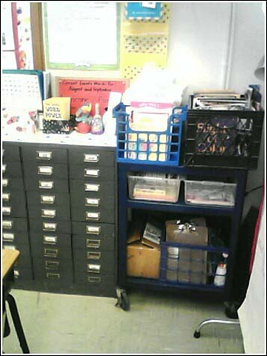
Class games and manips cabinet- Anything I need to grab during a lesson is here: dice, number cards, work mats, alphabet cards, etc., right next to my teaching area. On top you can see my “current events words for August/September” so children can reference words that they might want to spell correctly for awhile but don’t need to memorize and probably won’t need much later on (some of this month’s words are Ivan, Frances, Jeanne–names of hurricanes we have had close calls with!!). After the month is over, the charts will be available for students to access but not displayed.
Reading group cart- As you read in the room set-up section at the top of this page, I had to give up my small group reading table and conduct groups on the couch and rug with clipboards or at desks. So, I keep all of my reading group materials on this rolling cart (which was supposed to be for my overhead projector). When it’s time for small groups, I just roll the cart over to whichever group I am working with, or pull the crates out.
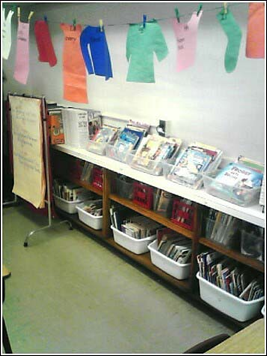
Reading area- Okay, so I spent hours this summer making adorable genre labels for my book bins (I got them for free through teachingheart.net). Then I realized my kids do not have the skills to read the majority of them because they’re chapter books! So I put the majority of my books in large dish tubs (a dollar each at Wal-Mart, and they durably hold dozens of books). These are stored on the bottom shelves. The bins on top are the ones the kids use–a big one with picture books and a small one with easy readers for each team. Each bin is numbered so that it is put back correctly. I am in the process of sorting them by genre, anyway, but it’s taking forever because there are so many books.
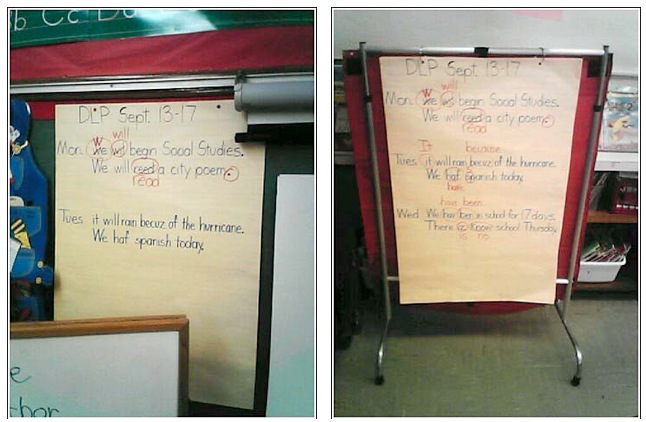
DLP chart- This is what my students do for morning work. I have two sentences on the chart and each has two mistakes in grammar, punctuation, capitalization, or spelling. After the kids finish, we go over it together. Lately I have been making one sentence a question for them to answer, such as “Wat did yu do last night?” [sic], and if they have time, they can write the answer while they wait for the others to edit.
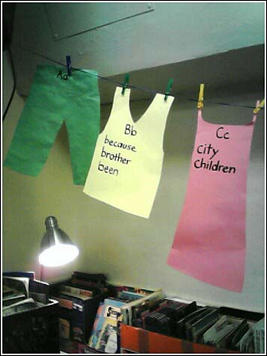
Word wall- Remember, nothing can be hung on the wall unless it’s a bulletin board, so I had to be creative here! The loooong blank wall was driving me nuts, so I tied string up to the ceiling tiles (don’t ask me how–a combination of trial and error and a wad of masking tape) and used clothespins to clip ‘clothes’ to the laundry line I had created.
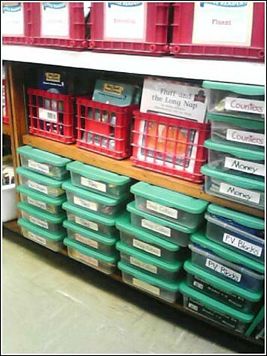
Shelving- This classroom has tons of it! In addition to the classroom library which takes up the better half of the shelves, I also keep books on top the phonics library (small group readers from the Houghton-Mifflin series). Underneath are containers of math manipulatives for each student (provided by the school: in my previous school, this was not done so I made up baggies myself). I actually found it a pain to get out a big old container for each child when we rarely use more than 1 type of manip per day, so I put all the counter baggies in a few containers, all the place value block baggies in other containers, etc. Now I just ask helpers to take the containers and pass one baggie out to each child. I also keep some of my own materials on the end shelves–the wooden box holds stickers and stamps, etc.
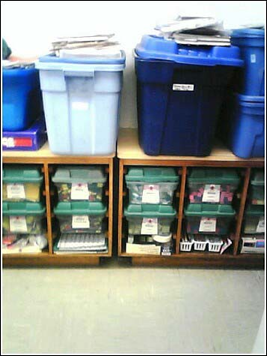
Teacher storage area- I have always wanted a huge section of the room to put all of my stuff in instead of having it stored all around the room. Almost all of the materials I need are in this one corner behind my desk, with the exception of the things stored in the storage closet. People ask how I stay so organized–let me tell you, this took HOURS to get together. But it’s the only way I can actually use all of the materials I have. If they aren’t easily accessible, I won’t use them. To me, it’s worth it to stay after school until 6 or 7 for a week and get it all together than to be scrounging around for ways to teach different concepts for the rest of the school year.
(No picture) My desk- I organize my desk pretty much as I did before, but this desk is much larger (thank goodness!) and holds a lot more.
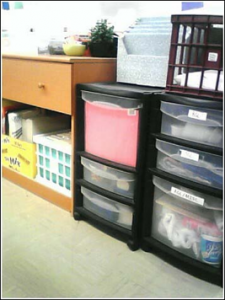
Storage- On the left you can see part of the infamous IKEA bedroom set from my old apartment, but when I loaded it up with paper storage, the two lower drawers broke. I really need storage, though, and until I can find myself an abandoned shelf in the school, I’m going to keep it. The top drawer still holds blank paper and chart strips, and the bottom is the perfect size for construction paper storage. On top are the “IN” baskets where kids turn in their papers. The little green apple container was a gift from my co-worker at my old school (whom I miss dearly!) and I use it to hold things I confiscate temporarily from kids. Not stuff like toys: those go in my desk and they don’t get them back until a parent sends in a note. I’m talking about the kids who play with their pencils, erasers, etc. during instruction. I never say a word, just walk by and take it out of their hands and deposit it into the green apple.
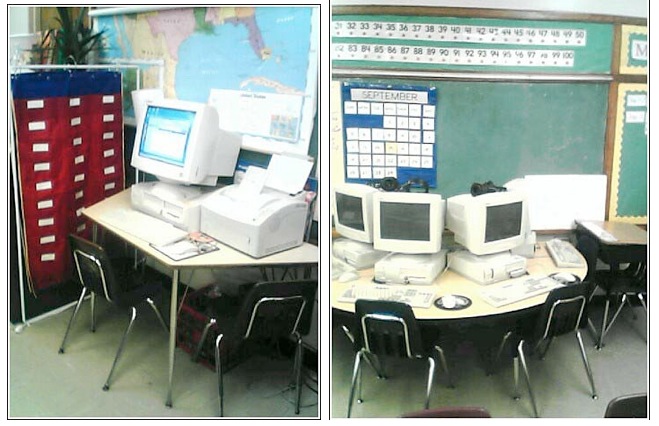
Computers- My area is the one on the left. The teacher in the room before me used the u-shaped table for computers and I kept it that way. I like that the kids can’t see one another’s screens while they are working.
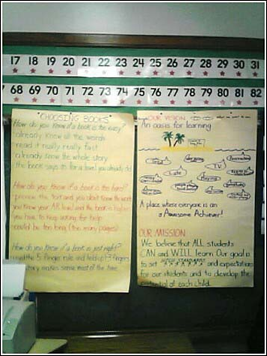
Back board- Here’s our chart about choosing books that are ‘just right’, which we generated as a class, and the school’s vision and mission statements, which all staff and students are required to memorize. I tried to help them make sense of all the big words by illustrating as much as possible (don’t you love all my ‘sharks’ in the water which distract the kids from learning? They named things that make it hard for them to make education a priority and I wrote each one on a shark in the water, and then I showed them how the school is like an oasis with none of those distractions, so we say we are an oasis for learning… etc.).
Math words- Organized by chapter.
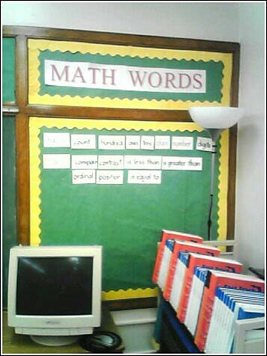
Cart storage- I keep extra textbooks, dictionaries, atlases, etc. on this cart. The side against the wall holds the materials we rarely use. I still have my TV trays, which I store here, too.
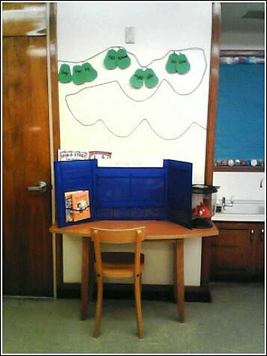
Writing center- Here’s more furniture from my guestroom that migrated to the classroom after my move. This was a sofa table and desk chair, both from IKEA. I was going to use it for a writing center in which students could choose a prompt or activity for their morning work, but my students are not independent enough for that yet. So I think I’m going to use it for enrichment activities for early finishers. My class is a TEAM class (Teaching Enrichment Activities to Minorities), which means some of my students have the potential to be in the gifted program next year and need additional problem-solving and higher-level thinking skills in preparation for the program. I have not yet had the training (and therefore probably did not explain that well), but when I do, I’ll set up the center and take pics. I have always had my third graders read a book when they finish their work, but this class is not ready for that yet. I think that having a choice of activities to take back to their seats (with some computer options as well) will be better. I have a few kids who are done in less than a minute flat and others who would spend an hour on the same task, no exaggeration. I’ve got to get a program for that first bunch so I can work with the second bunch.
Pair of pears homophone board- This stays up for reference.
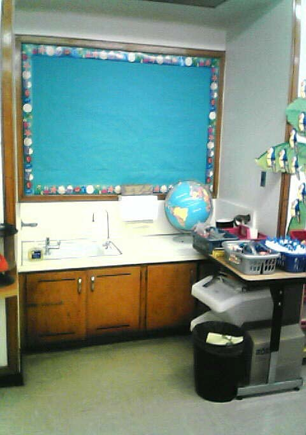
Sink area- Teams get drinks from the water fountain here when called throughout the day (quite often, as it is so hot here). I think I will make this board a social studies or science display for student work. I use the cabinets under the sink for soap, hand sanitizer, baggies, etc.
Art supplies- All stored here. No glue or scissors are kept in students’ desks because they would be used more often for making messes and playing around than they would for completing assignments since I only give cut-and-paste stuff once a week or so. Underneath are old magazines for cutting up and for scrap paper. (Warning for new teachers–look through EVERY page of a magazine before putting it out for kids. There are so many inappropriate things in every publication that some teachers I know actually rip out the appropriate pages and throw the magazine away instead of vice versa!).
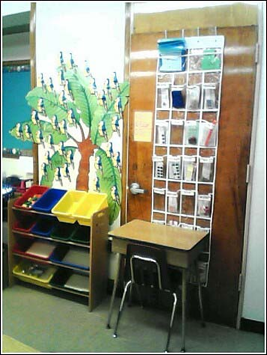
Centers and math tubs- I’m not using these yet because the class isn’t ready, so I don’t have a plan for how they’ll work.
Descriptive writing/ Synonym palm tree- This is a commercially-made display I bought from a teacher store as a treat to myself after getting a job in Miami. Since I have no window, it really makes me smile to see the palm tree as a reminder of the beautiful place that awaits me outside! On each leaf/branch (guess I need to learn the terminology, huh?) I will write a commonly used word pulled from a story we’re reading. For example, we just read ‘Dragon Get By’ which was about Dragon eating. We brainstormed synonyms for ‘ate’ and searched the story for more descriptive ways the author wrote ‘ate’, such as ‘crunched’ and ‘gobbled’. I wrote one synonym on each parrot and placed the parrot on the corresponding palm branch. This stays up for spelling and vocabulary reference and also for use in descriptive writing assignments.
And then…
November 2004- I left my job in Miami. Yes, after ALL THAT WORK! It was a very difficult decision, because there were SO many wonderful things about the school. But there were some systemic issues that were out of my hands and in many ways, out of the hands of my administration. A few incidents occurred that made it dangerous to teach, and it got to the point where I felt like I was not safe nor was I empowered to keep my students safe.
I was unable to get a transfer within Miami-Dade county due to contractual obligations (the district requires new teachers to be assigned to the same school for three years!) I felt that leaving the school system altogether was my only option: I could have stuck it out for the rest of the year, possibly, but what was the point if I was going to have to put in two more years in the same place? It was time to move on for my own sanity. I knew that there were a lot of vacancies in nearby Broward County and began submitting applications. Within a week I had secured a position and resigned from my previous school.
[Note: A lot of teachers have written me asking how I was able to do this so quickly and easily. All I can say to that is, God had his hand on me the whole time and was preparing the way. I felt very guilty for ‘abandoning’ my students, and I felt like I had failed at what I was called to do. All I knew was that in my new school, I enjoyed teaching again and was so much less stressed out. After only a few short weeks, though, God revealed His plan for me: my new school was MUCH closer to my church, and since I was not taking so much work (and emotional burdens) home at the end of the day, I have been freed up to serve more in the church and grow in my spiritual walk, which was really dwindling due to my exhaustion from my job. Even more exciting, God has recently called me to serve the same population that I used to teach, only in a different way: I am now working in the Women’s Prison Ministry through my church! I am able to reach the mothers of the children who go to school unprepared and hurting, and impact their communities at their true roots: the families our students come from and the home lives they grow up in. This is a brand-new opportunity for me, and I feel honored that God has chosen to use me this way. I may write more in the Blog about it, but I will refrain from mentioning it here to stay on topic! ]
So, now I am teaching third grade again! But, the drama is STILL not over! You see, my school is overcrowded and the new building addition is not yet finished, although it is close. I am therefore sharing a classroom with another teacher! We have 45 students between us all in one room! But, it WORKS! These are great kids, not a behavior problem in the bunch, and my co-teacher is fantastic. I am not unhappy with the situation but I do feel for the kids with ADD/ADHD because it is hard to concentrate with so many distractions all around.
I have been reluctant to take pictures simply because the classroom is not my own! I have adopted many of the routines and systems that were already in place when I arrived, so I wanted to wait until I had my own room (supposedly in January 2005) to put pictures on the site and post my new procedures. However, since it’s nearly March, I figured I better just put up what I’ve got!! So, what follows is the classroom I share with my co-teacher and the routines we have fine-tuned over the last few months together. [I’ll try to post info soon].
April 2005- The time has finally come for us to move into the new building! The entire first grade is moving to the bottom floor, and the third grade is moving to the second floor. We like the idea of being altogether, but the rooms are NOT designed for lower elementary students and we have almost no shelving. Still, I am excited about starting a brand new room. Here’s the process:
This is what the classroom looked like when I first walked in. HUGE change from the large bright bulletin boards and extensive built-in shelving and drawers from the original building. It looks like a secondary classroom, doesn’t it? I’ve got a big challenge ahead of me.
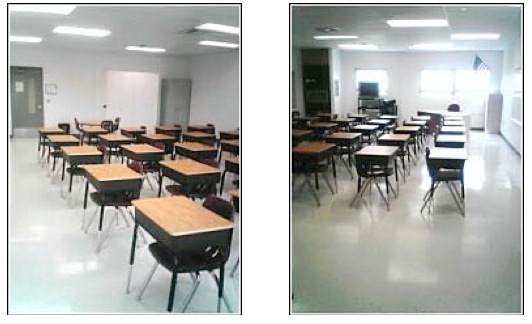
The first step was getting the furniture in place. I planned everything out on paper first, then spent less than ten minutes pushing everything into the spaces I wanted it in.
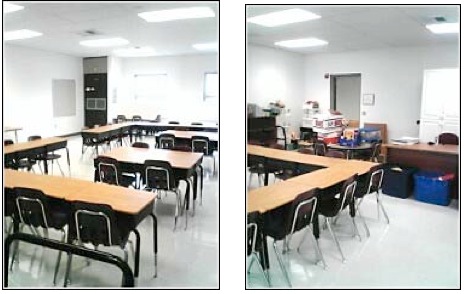
Next I stayed after school for about 2 hours and moved all of my stuff to the new room. The school system is actually paying movers to do this in a few weeks, but why wait? 20 teachers can’t all use the movers at the same time, anyway, and it’s not the actually moving that’s a pain–it’s cleaning out the room and determining what to keep, and unpacking/organizing in the new room. The movers can’t do that anyway, so I decided to get a head start and do it little by little. Here’s a picture of all of my junk piled up inside the doorway of my room. I have gotten rid of so much moving from school to school the way I have–I have maybe a third of what I had when I moved from Maryland.
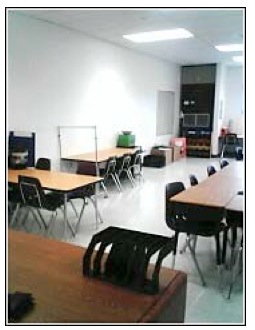
It’s starting to look like a real elementary classroom! I spent three hours on spring break putting stuff away and setting up my centers. Here you can see (from left to right) my writing center, computer table (without computers, LOL), math area (open so kids can play games on the floor and can sit at my feet while we do Everyday Counts math), and the reading area (no bookshelves, just a table–we’re working on that). Not pictured is the science/social studies area. I haven’t decided what to do about reading groups yet. I may have the kids sit on the floor in the back, or have them sit in their reading groups at desks and instead of them coming to me, I’ll come to them. With 7 or 8 students in each reading group, it’s impossible to fit them around one table, and I’d rather try something unconventional than cram them in.
I have plenty of storage and am working on a plan for organizing it over spring break (just planning, not actually going back into the school and working anymore!) As I have time, I’ll go into the room and move things around. We should be moving in about two weeks, right after first and second grades take the SATs. I’d like to make the first date in the new room April 11. That will give us six weeks before the end of the school year. In a way that seems like a waste, but I’m looking forward to trying new routines: this year’s class will be kind of like the guinea pigs so I don’t have to start next year with one set of procedures and then change them right away. The kids I have now have already been trained and are independent, since they’re basically ready for fourth grade, so they can give me a good idea of what to shoot for and an ideal goal of where I want next year’s class to be. I am looking forward to doing far less whole-class instruction and more projects and centers.
MAY 2005- Well, we finally moved in! But I’m not really setting up the bulletin boards, centers, etc. because school is almost out. Stay tuned for the 2006 pictures!
More of My Classroom Tours

Classroom Photos After 2009
Classroom Photos 2009
Classroom Photos 2008
Classroom Photos 2007
Classroom Photos 2006
Classroom Photos 2004
Classroom Photos 2003
Classroom Photos Before 2003
Check Out Other Teachers’ Classroom Photos
Want to see photos of Other Teachers’ Rooms? I’ve collected classroom pictures from educators in all different parts of the United States! Learn their tips for desk arrangement, organization, and more.
Please Share YOUR Classroom Photos!
Would you like to have your pictures featured here? I’d love to add your classroom pics to the Other Teachers’ Rooms page! Contact me via email with the link to your Flickr, Tumblr, Picassa, blog, Pinterest board, or even a public Facebook album! Don’t worry about making sure everything looks perfect: we want to see REAL classrooms that are used by REAL students every day! International teachers–we’d especially love to see what your rooms look like!

Angela Watson
Founder and Writer
Sign up to get new Truth for Teachers articles in your inbox
OR

Join our
community
of educators
If you are a teacher who is interested in contributing to the Truth for Teachers website, please click here for more information.















